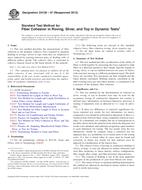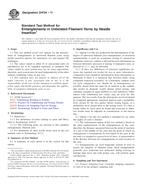Potřebujeme váš souhlas k využití jednotlivých dat, aby se vám mimo jiné mohly ukazovat informace týkající se vašich zájmů. Souhlas udělíte kliknutím na tlačítko „OK“.
ASTM D1423-02(2008)
Standard Test Method for Twist in Yarns by Direct-Counting
Automaticky přeložený název:
Standardní zkušební metoda pro Twist v historkách přímým započítání
NORMA vydána dne 1.7.2008
Informace o normě:
Označení normy: ASTM D1423-02(2008)
Poznámka: NEPLATNÁ
Datum vydání normy: 1.7.2008
Kód zboží: NS-17237
Počet stran: 7
Přibližná hmotnost: 21 g (0.05 liber)
Země: Americká technická norma
Kategorie: Technické normy ASTM
Kategorie - podobné normy:
Anotace textu normy ASTM D1423-02(2008) :
Keywords:
twist, twist factor , twist multiplier, twist take-up, yarn, Direct-counting technique, Twist--textiles, ICS Number Code 59.080.20 (Yarns)
Doplňující informace
| Significance and Use | ||||||||||||||
|
Test Method D 1423 for testing twist in yarns by direct-counting is considered satisfactory for acceptance testing of commercial shipments because current estimates of between-laboratory precision are acceptable and the method has been used extensively in the trade for acceptance testing. If there are differences of practical significance between reported test results for two laboratories (or more), comparative tests should be performed to determine if there is a statistical bias between them, using competent statistical assistance. As a minimum use the samples for such comparative tests as homogeneous as possible, drawn from the same lot of material that resulted in the disparate test results and randomly in equal numbers to each laboratory. The test results from the laboratories involved should be compared using a statistical test for unpaired data, at a probability level chosen prior to the testing series. If a bias is found, either its cause must be found and corrected, or future test results for that material must be adjusted in consideration of the known bias. The determination of twist in a straight section of a yarn is not the simple straightforward operation it appears to be, for the test results may be greatly influenced by variations in test procedures and techniques. In all manipulations, extreme care is necessary to prevent specimen rotation altering the twist level before testing begins. The twist in a yarn before it is packaged may be different from that of the yarn after it has been withdrawn from the package because of changes in tension and the effect of the method of withdrawal. If the yarn is withdrawn over-end, a slight increase or decrease in twist will take place, depending upon the direction of the twist in the yarn, the direction of winding on the package, and the length of the wrap on the package. When a yarn is incorporated into or removed from a more complex structure, alterations may occur as a result of the plying, untwisting, or raveling operation. For example, when determining the twist in plied yarn by the procedure for determining original twist, as the plied yarn is untwisted, a comparable amount of twist is reinserted in, or removed from, the single-yarn components. As a consequence, the single yarns have approximately the original twist prior to the plying operation but not the twist they have when they are functioning as components of the plied yarn. The latter or final twist may be estimated by adding the ply twist to (or subtracting it from) the single-yarn twist depending on the directions of the ply and singles twist. For a more precise determination, the test procedure must be modified. There are thus two different procedures for preparing specimens of the component elements of a plied or cabled yarn for twist determination. The procedure for the original twist measures the twist in a component of a complex strand after the components have been untwisted. The procedure for final twist measures the twist in a component as it lies in the complex strand. Although the original twist procedure is most often used, selection of a particular procedure will depend on the type of information needed. Note 3—The difference in twist between unwinding from the side and over-end is 1/πd, where d is the diameter of the package. Thus, for a 25-mm (1-in.) diameter package, the difference would be about 13 tpm or about 1/3 tpi. When a yarn is taken from a more complex yarn structure or from a fabric, the resultant twist should be considered only an approximation of the original value because of alterations that may have occurred as a result of the effects of unwinding, handling, and mechanical strains met in processing. The optimum amount of twist depends upon the use for which the yarn is intended. The amount of twist affects both the strength and elongation properties of the yarn with increased twist being associated with increased elongation. The relationship between twist and strength is more complex. In filament yarns, some twist up to 280 tpm (7 tpi) or a suitable sizing is required to facilitate textile operations. A small increase in twist results in a slight increase in strength, but a further increase results in a loss in strength. However, higher twist in such yarns may be used to subdue luster or increase elongation, or to secure other special effects, as in crepe fabrics. In conventional ring spun yarns a certain minimum amount of twist is necessary to bind or hold the individual fibers together to produce a useful yarn. A limited increase in twist will result in an increase in strength until the critical twist level for the particular yarn involved has been reached, but further increase in twist results in a loss in strength. The same amount of twist in yarns of different sizes (diameter) will produce yarns with different degrees of compactness, twist character, and twist angles. The twist multiplier or twist factor is approximately proportional to the tangent of the angle that the surface fibers make with the axis of the yarn. Therefore, the greater the angle, the greater the twist multiplier. A constant twist multiplier indicates comparable compactness and degree of liveliness in yarns of different sizes and conversely a difference in twist multiplier indicates a difference in compactness in yarns of the same size. Yarns intended for different uses are frequently made with different twist multipliers, for example, warp yarns and filling yarns. Different cabling processes will influence the calculation of twist from single component twist measurement. The length of cabled yarn before untwisting is used for the calculation of twist for single components using direct cabling technology. In case of 2 or more step twist technology the length of the cabled yarn after untwisting is used for calculation of the twist level in the single yarn components. |
||||||||||||||
| 1. Scope | ||||||||||||||
|
1.1 This test method covers the determination of the amount and direction of twist at the completion of any stage of twisting in single (spun or filament), plied, cabled, or novelty (exclusive of long-term repeat patterns) yarns. The procedures are designed primarily for yarns in packages, but, with special precautions, they are applicable to yarns taken from fabrics. The procedure for spun yarn in 9.2 is also applicable to rovings. 1.2 For plied yarns, this test method covers the determination of the twist of the plied yarns and the twist of the single yarn before plying. For cabled yarns, the test method covers the determination of the cable or hawser twist; the twist of the plied yarn after plying, but prior to the last twisting operation; and the twist of the single yarn before plying. Procedures are also included for the determination of the twists of the single and plied yarn components as they lie in the final structure. Also, directions are included for the determination of twist in plied yarn made with direct cabling technology. 1.3 This test method is not intended for yarns that extend more than 5.0 % when tension is increased from 2.5 to 7.5 mN/tex (0.25 to 0.75 gf/tex). Following the procedures of this test method for such yarns would be independent of the bias and precision determined for this test method. The report from such testing should include the tension used for this testing. 1.4 The values stated in either inch-pound or SI units are to be regarded separately as standard. Within the text, the SI units are shown in parentheses. The values stated in each system are not exact equivalents; therefore, each system shall be used independently of the other. Combining values from the two systems may result in nonconformance within this test method. Note 1—For a more rapid but less accurate method of determining twist in single spun yarns, refer to Test Method D 1422. Note 2—This test method has been evaluated for use in determining twist in open end yarns and is not recommended. 1.5 This standard does not purport to address all of the safety concerns, if any, associated with its use. It is the responsibility of the user of this standard to establish appropriate safety and health practices and determine the applicability of regulatory limitations prior to use. |
||||||||||||||
| 2. Referenced Documents | ||||||||||||||
|
Podobné normy:
Historická
1.6.2010
Historická
1.2.2012
Historická
1.7.2012
Historická
1.7.2012
Historická
1.1.2011
Historická
1.10.2013
Odebírejte informace o nově vydaných normách ZDARMA:
Chcete pravidelně odebírat informace o nově vycházejících normách z celého světa a to zcela zdarma?
Přihlašte se k odběru. Vše je velice jednoduché a absolutně ZDARMA.
Na výběr máte vydavatele z celého světa.



 ASTM D3693-02(2010)..
ASTM D3693-02(2010).. ASTM D3823-07(2012)..
ASTM D3823-07(2012).. ASTM D4031-07(2012)..
ASTM D4031-07(2012).. ASTM D4120-07(2012)..
ASTM D4120-07(2012).. ASTM D4724-11
ASTM D4724-11 ASTM D4849-13e1
ASTM D4849-13e1
 Cookies
Cookies
